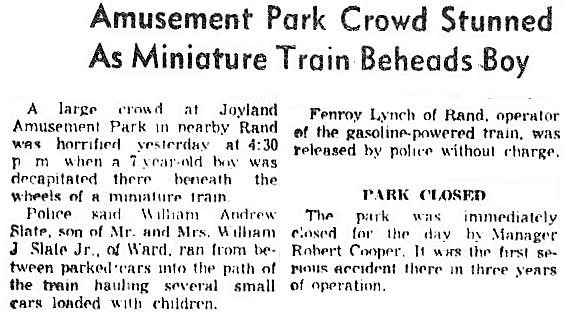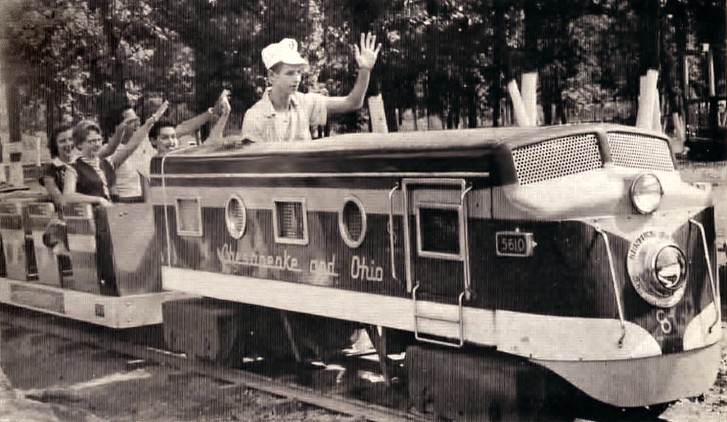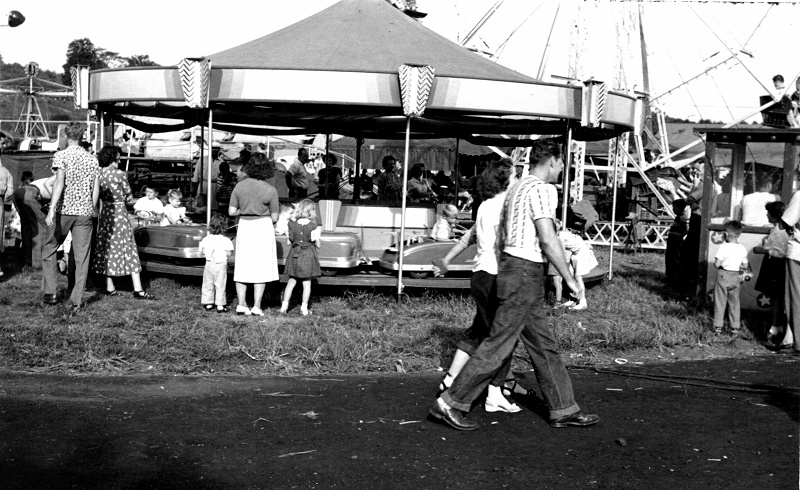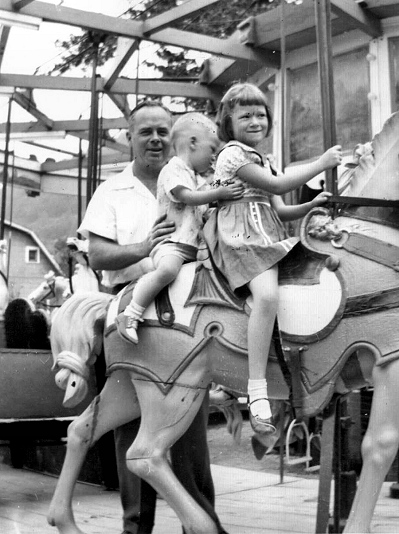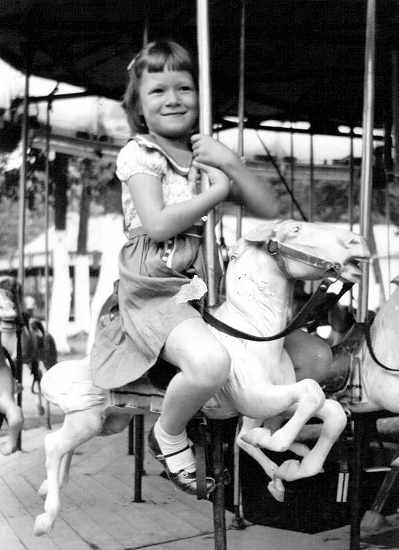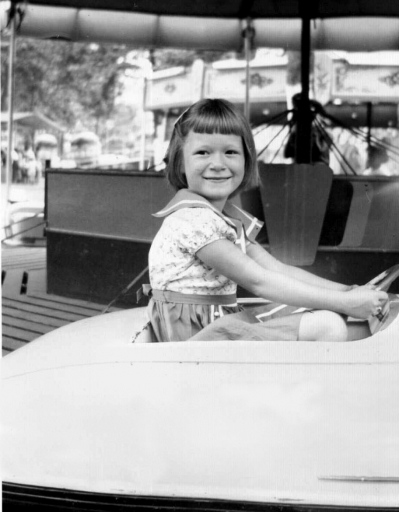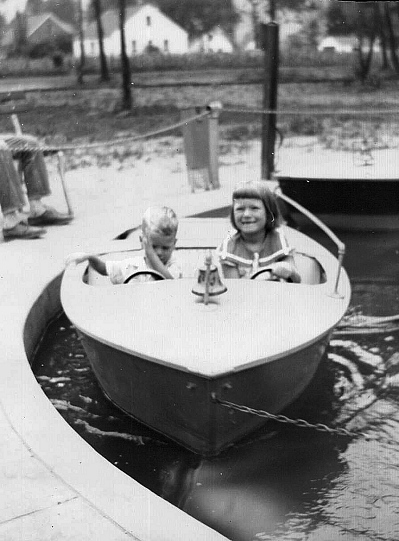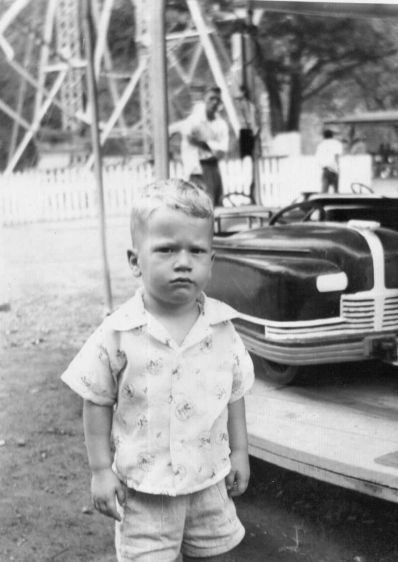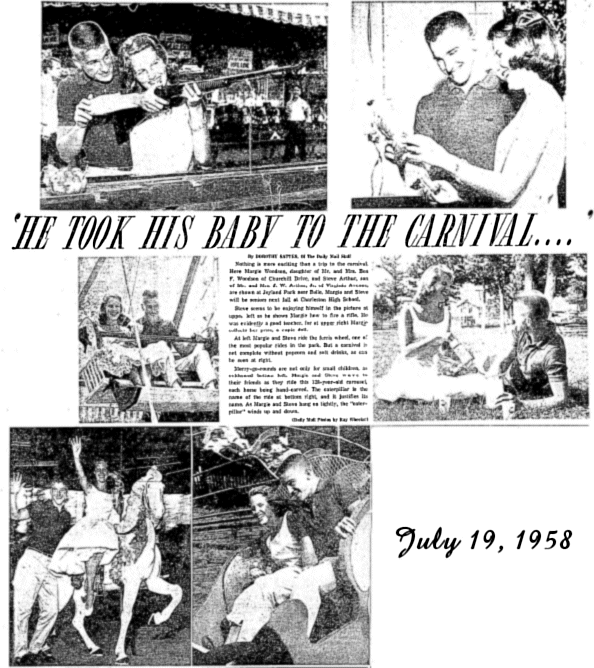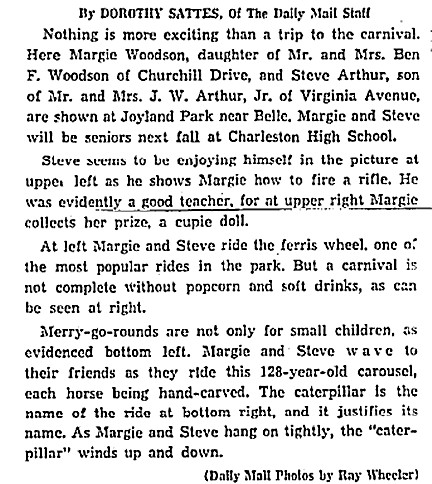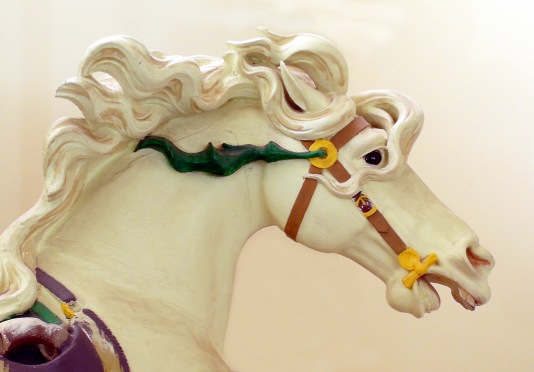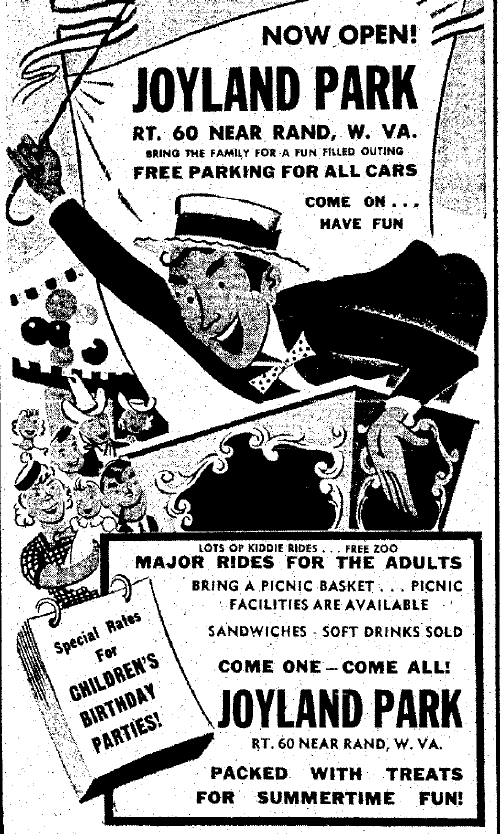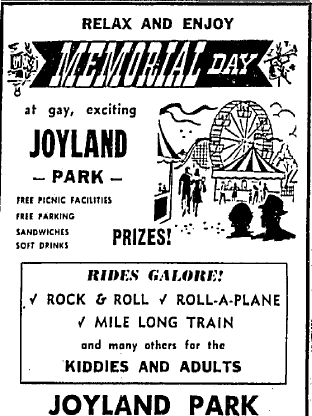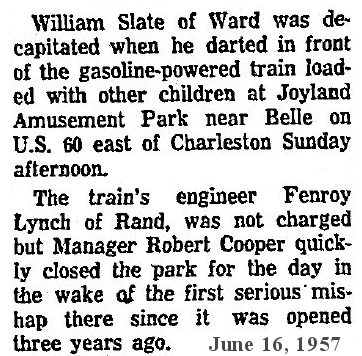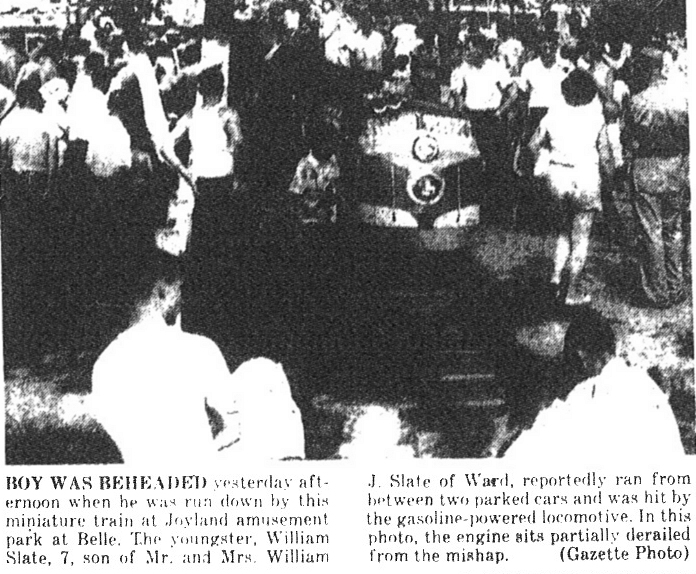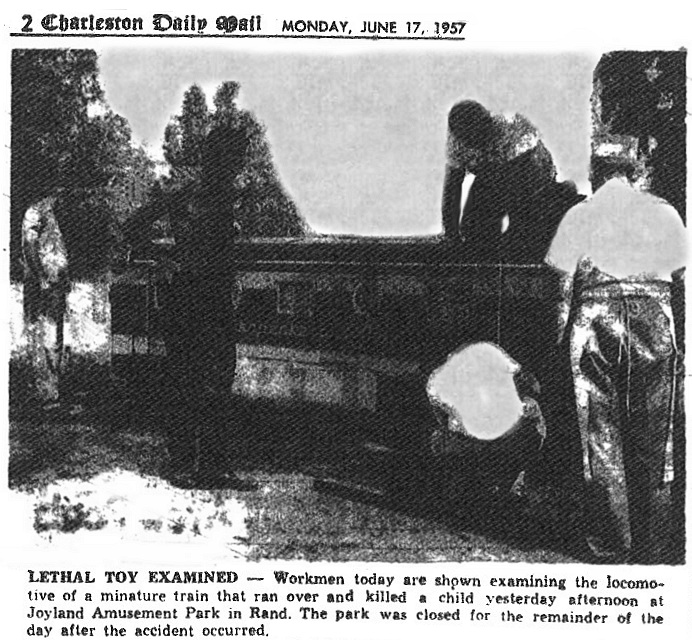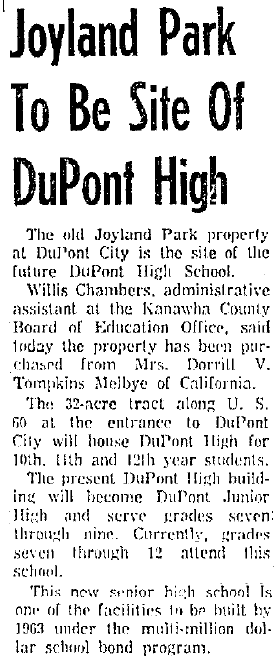|
The park was developed by
Johnny Denton who owned Gold Medal Shows, a carnival that toured
several states, and I think another one that traveled under his name.
The constant setting up and tearing down eventually takes its toll on
even the best rides and equipment, and it becomes too costly to
continue. In Joyland he must have felt he could extend the life of some
of his aging equipment.
Although Denton was the
primary force behind the park and surely had the biggest stake, he
wasn't the only one involved. Joyland was home to several colorful
entrepreneurs during its brief existance, including Bobby Cooper, Natie
Brown, John Swisher, the Picozzis, the Carters, and the Millers. Each
of these brought their own unique talents and offerings, but only
Cooper, who was in his mid to late twenties at the time, brought both
rides and concessions.
Conley and I started working
at the park at about the same time, and we both worked full time that
first summer. "There were nine of us and we never had much," Conley
recalls. "Times were tough back then and there weren't many jobs
around, so I jumped at the chance to go to work for $3.00 a day." I
worked off and on at the park the next two seasons, but Cooper
persuaded Conley to go to work on a rail carnival for his sister in
Canada, and paid his way to Philadelphia to meet her. Conley recalls
that he spent "the next four or five years on the road, first in
Canada, then back in the states," and adds "I learned more during that
period on the road than I could have learned anyplace else."
By today's standards, the
park would be considered small, but at the time it was quite nice.
There were usually six or more full size rides, including the bumper
cars, ferris wheel, tilt-a-whirl, octopus, carousel, and the Joyland
Railroad that nearly encircled the park, plus one or two others that
would be set up from time to time depending on what wasn't needed on
the road. For a while there was even a portable roller skating rink.
There were also numerous kiddie rides including live ponies, and a
roller coaster that always seemed too large for most kids and too small
for most adults.
One ride that was truly
memorable was the 150-year-old German made carousel Denton brought down
from Cleveland for the grand opening on May 21, 1955. The Charleston
Daily Mail's Bob Jarrell, in his Roving the Valley article of August 5
that summer, cited ride superintendent Arthur (Dutch) Ream in
describing the ride's 36 horses, that some were "almost as large as a
real pony. All the horses have lifelike glass eyes, something you don't
see nowadays on merry-go-rounds." My younger sister Kathy recalls,
"When I think of Joyland, I always think of the carousel and this one
particular big white horse, my favorite. It was the most beautiful
horse in the world."
***SEE ONE OF THE ORIGINAL HORSE'S BELOW***
I have no idea what the
attendance figures might have been, but the park was often packed and
was particularly popular with students and other young people. Gerald
Terry, a real estate appraiser with Goldman Associates, Inc. in
Charleston, remembers the free rides and sodas he earned at Joyland.
"They had a policy of rewarding students with free drinks and rides for
each "A" on their report cards. I always made good grades so I'd go and
get several free things." Darrell Daniels, news director at WQBE,
remembers the park as a great place to meet friends and hang out on
weekends, "I've got some wonderful memories of Joyland. As a student I
didn't have much money to spend, but it was great to be able to get
together with friends in a wholesome atmosphere."
Among Joyland's favorite
offerings were the concessions, including various snack bars as well as
games of both skill and chance, the largest of which was the daily
skilo game that became a mainstay. Bingo was illegal at the time, but
the law had been rather narrowly drawn, so at the park we played skilo.
Why the law was written so narrowly is not known, but for years a
majority of members of the West Virginia House of Delegates from
Kanawha County had last names beginning with A, B, C, or D, presumably
the result of our former practice of listing candidates alphabetically
on ballots.
Regardless of the reasoning
behind the bingo law, one person who benefited was Natie Brown who
owned the skilo concession. I met Natie the first summer the park was
open. I had just finished the ninth grade and wouldn't celebrate my
15th birthday until October, so the chances of landing what might have
been considered a good summer job were minimal. Like other kids my age,
I started hanging around the park the minute it opened. It was
exciting, and before long I had the opportunity of going to work for
one of the vendors, "Honest John" Swisher, his nickname for himself. I
hired in at $2.00 per day. The park jobs didn't pay much, but at least
they gave a lot of us a chance to learn some responsibility. My sister
Nancy worked in one of the ticket booths for a while that first year
before getting a job at a lunch counter in one of Charleston's five and
dimes.
John owned and ran a grab
bag concession, located in the middle of the midway in front of the
main snack bar, and everyone won something. "Hey folks, come on over.
Fool ol' Charley and win a doo-la-ly." First it's John's voice I hear,
then mine. It didn't matter that neither of us were Charley, the line
usually worked whether I was working the grab bag booth for John, the
duck pond for the Millers or any of the other concessions.
When Swisher wasn't at the
park he was most likely working a carnival or fair someplace, and if
nothing else was happening he could often be found selling men's
hosiery down at Dead Man's Curve. That was down by Dickenson Field
where a near 90-degree right turn connected the four-lane with the two.
There was nothing fancy about the hosiery operation, just the socks and
the large cartons they came in. He'd park the truck and set the boxes
out. A couple of crudely marked signs, and he was in business selling
the seconds, thirds, and irregulars he frequently brought up from the
mills in North Carolina.
If things got slow, he might
even grab a stick and poke around inside a large empty carton as if
there were something in it. Those who stopped to investigate would
often end up buying something. It was hard not to buy from Honest John.
I can't remember his wife's name, but she was a real nice lady who
helped him a lot, either at the park or on the road with him, and
although I was quite young, having me there seemed to give them a lot
more flexibility.
I worked six days a week in
that crowded little grab bag booth, so full of the cheap aluminum
jewelry and other items bought from Mackie Supply, Natie Brown's
wholesale supply company in Charleston. Mackie was located on Virginia
Street across from City Hall where the United Bank Building now stands.
A native of Philadelphia, Brown moved to Charleston about the same time
the park opened and was involved from the beginning. He had been a
highly rated heavyweight boxer in the thirties and had the distinction
of fighting many top contenders, including Max Baer, Maxie Rosenbloom
and Joe Louis. He met Louis twice, losing by decision in ten rounds in
1935 and being knocked out in four in 1937, the second fight being
Louis' last before winning the championship from James Braddock who had
won it two years earlier from Baer.
In Joe Louis: My Life, an
autobiography written with Edna and Art Rust, Jr., Louis had this to
say about their first meeting, "I wanted to make a good impression, but
I was nervous and overanxious. That March 28 was some trial for me.
Natie Brown was what you call a spoiler. He was trying to show me up,
and I could hardly get through his guard. I had him down in the first
round, but he stuck it out for the limit. He was clumsy and had an
awkward style that would make anyone look bad. I decisioned him in ten
rounds, but I didn't feel happy about it." Brown died in 1991 and
Charleston lost a colorful sports figure.
Little is known about the
Carters except that they were related in some way to Cooper, possibly
through Cooper's wife, and they either owned or managed the main snack
bar. One story I remember hearing from either Johnny Denton or Mr.
Carter - I think it was Carter - was that at some time in the past they
had experienced a larger than expected crowd and ran out of hamburger.
Lots of bread he said, but no meat. Instead of panicking they just
crumpled the bread and moistened it enough to form patties, fried it in
hamburger grease and served it bread on bread with garnishments. They
never had a complaint, he added.
On several occasions I
helped the Millers who ran the duck pond. They were a wonderful old
couple who seemed relieved to be living at a slower pace than before.
They once owned several rides and made a lot more money, but as they
got older they seemed content. I liked them and they showed me some
photos from their glory days of old, but by far the most interesting of
all the people I met at Joyland were Bill and Ginger Picozzi. The
Picozzis owned both food and game concessions, and although I didn't
know them well, I must have worked in one or more of their concessions
at some point. I think I worked in every game concession in the park at
one time or another, plus I ran some of the kiddie rides.
I hadn't seen them in over
20 years until about 1980 when I renewed the acquaintance. Bill was
raised in the Little Italy section of Cleveland and, according to Bill,
Jr., a well known Charleston sports and entertainment promoter, "Dad
was a promising boxer who was undefeated after 44 fights when he
decided, toward the end of World War II, to get married." It was his
bride, Virginia "Ginger" Latlip, who had the strong family background
in the entertainment industry dating back to the early 1900s.
Her father, "Cap" Latlip,
had set a world record by plunging 112 feet from a pole into a small
pool, and became a partner in Hall and Latlip Shows which traveled by
rail throughout the eastern states and Canada. They also toured at
times as either The Latlip Family or Latlip Attractions. The family
moved to Charleston around 1917 and have been residents ever since.
They were featured in a 1979 Goldenseal article, "The Famous Latlips,
Charleston's Premiere Show Family" (Volume 5, Number 2).
Until tragedy struck in 1913
in the form of a train wreck, the show was so large it took 37 rail
cars to transport all the equipment and animals, which included horses,
elephants, lions, and tigers. The wreck resulted in the loss of a lot
of valuable equipment and several animals. For a while in the mid to
late thirties until the end of World War II, Ginger and her twin
sisters toured as a trio up and down the Atlantic Coast, and according
to Bill, Jr., "performed with Judy Garland and Bob Hope, and
entertained at USO Clubs during the war." After the war, Ginger married
Bill Picozzi who she had met five years earlier while performing in
Cleveland. They soon put together a full carnival and toured for a
while, before deciding to limit their activities to just a few
concessions and rides
Now their children are
carrying on. Connie has devoted much of her time to dance and beauty
pageant promotions and recently returned to Charleston, and Bill, Jr.
is busy planning his next promotions. When asked what he liked best
about Joyland, Bill replied, "the train ride, I was eight or ten at the
time." When asked what Joyland has meant to him though, his answer is
quite different, "What I took from Joyland and being raised in a
wonderful show business family are those things that have allowed me to
do as well as I have - a lot of common sense, a good nose for business,
and values." Speaking of values, in 1993 the Charleston Gazette carried
an announcement about Bill and Ginger's golden wedding anniversary.
Bill died later that year, Ginger in 1997. I called them after the
anniversary announcement to congratulate them and had a nice
conversation. I'm so glad I did.
Johnny Denton's decision to
use old equipment at Joyland came at a price, and the park's reputation
eventually suffered. Breakdowns are costly, not only to revenue, but
also to image - and possibly even to safety. Ride operators sometimes
had to double as mechanics, and mechanics as ride operators, and the
distinction between the two at times seemed blurred, giving the park a
"dirty" look. This was not the fault of the workers; it was the hand
they were dealt. Toward the end of Joyland's stay at the grove, a child
was fatally injured when he stepped into the path of an approaching
park train. Coming on top of mounting problems, the accident possibly
hastened the park's closing.
My walk down memory lane has
been a wonderful experience and has made me very appreciative of the
time spent at Joyland. The sounds of the midway got in my blood as a
boy, and I can't visit a park or carnival without wishing for a moment
that I was barking from one of the booths "Hey folks, come on over..."
I learned a lot during those three years, most importantly that these
were good, decent, hard working people that I am proud to say I knew.
Things may not always have been strictly on the up and up, the ducks
with the lucky numbers may not always have been in the water, and the
grab bags with the biggest prizes may not always have been in the box,
but in the bigger picture, the one that really counts, these wonderful
people always brought a lot more smiles than frowns.
|
